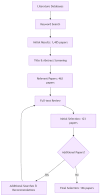Internet of Things-Based Automated Solutions Utilizing Machine Learning for Smart and Real-Time Irrigation Management: A Review
- PMID: 39686017
- PMCID: PMC11644754
- DOI: 10.3390/s24237480
Internet of Things-Based Automated Solutions Utilizing Machine Learning for Smart and Real-Time Irrigation Management: A Review
Abstract
This systematic review critically evaluates the current state and future potential of real-time, end-to-end smart, and automated irrigation management systems, focusing on integrating the Internet of Things (IoTs) and machine learning technologies for enhanced agricultural water use efficiency and crop productivity. In this review, the automation of each component is examined in the irrigation management pipeline from data collection to application while analyzing its effectiveness, efficiency, and integration with various precision agriculture technologies. It also investigates the role of the interoperability, standardization, and cybersecurity of IoT-based automated solutions for irrigation applications. Furthermore, in this review, the existing gaps are identified and solutions are proposed for seamless integration across multiple sensor suites for automated systems, aiming to achieve fully autonomous and scalable irrigation management. The findings highlight the transformative potential of automated irrigation systems to address global food challenges by optimizing water use and maximizing crop yields.
Keywords: artificial intelligence; crop productivity; edge computing; interoperability; precision agriculture; precision irrigation; remote monitoring; sensor networks; smart farming; water use efficiency.
Conflict of interest statement
The authors declare no conflict of interest.
Figures







References
-
- FAO . The Future of Food and Agriculture—Trends and Challenges. FAO; Rome, Italy: 2017.
-
- Ali M., Talukder M. Increasing water productivity in crop production—A synthesis. Agric. Water Manag. 2008;95:1201–1213. doi: 10.1016/j.agwat.2008.06.008. - DOI
-
- Playan E., Mateos L. Modernization and optimization of irrigation systems to increase water productivity. Agric. Water Manag. 2006;80:100–116. doi: 10.1016/j.agwat.2005.07.007. - DOI
-
- Rockstrom J., Falkenmark M., Karlberg L., Hoff H., Rost S., Gerten D. Future water availability for global food production: The potential of green water for increasing resilience to global change. Water Resour. Res. 2009;45:W00A12. doi: 10.1029/2007WR006767. - DOI
-
- Zhang J., Xiang L., Liu Y., Jing D., Zhang L., Liu Y., Li W., Wang X., Li T., Li J. Optimizing irrigation schedules of greenhouse tomato based on a comprehensive evaluation model. Agric. Water Manag. 2024;295:108741. doi: 10.1016/j.agwat.2024.108741. - DOI
Publication types
LinkOut - more resources
Full Text Sources

